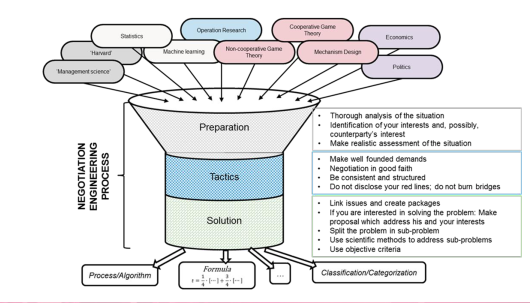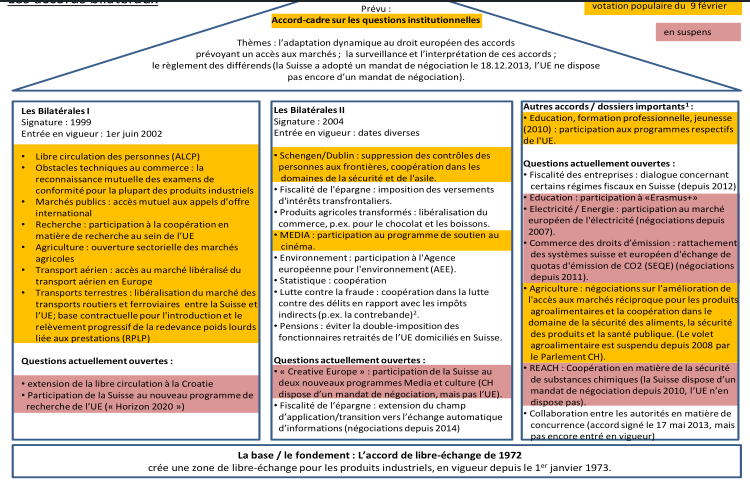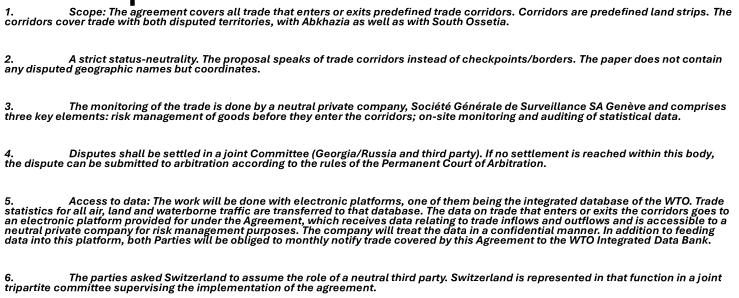Managing complexity in negotiation
What is diplomatic engineering?
- Science in diplomacy refers to evidence based foreign policy.
- Bases diplomacy on scientific criteria and scientific literature about obstacles and favorable conditions of negotiation (ex. strategic game theory or the Harvard method).
- Diplomacy for science refers to foreign policy that promote STI (Science, Technology, Innovation) to solve common problems.
- Science for diplomacy refers to the rôle of science in coalition building and conflict resolution (apply hard-science tools to a negotiation process).
- The diplomatic engineering is a process-based approach. It tries to apply scientific methods to negotiation processes. It is rooted in real word negotiation experiences.
- E.g.: Georgia and Russia WTO negotiations after the war.
Graphical representation

Preparation
First, you analyse the position and interests of the different parties. E.g.: what are the interests behind the US-led peace negotiation in Gaza?
- Geopolitical rebranding.
- Nobel Peace Prize.
- Investment in the reconstruction of Gaza. Secondly, you decompose the problem (decomposition): split problems into less complex subproblems. As such they are reduced to a technical levels, at the lowest level possible, so that solutions will be reduced to a technical state as well.
- Subproblems are categorised trough objective language, broken down to its smallest parts, using statistic criteria among others to find solutions. Using mathematical representation isn’t a must, but facilitates things.
- Then tools are applied heuristically (solution-oriented).
- The DFAE invented this method thinking of watchmaking, which isn’t surprising given we are a country of engineers.
The spirit of diplomatic engineering
- Diplomatic Engineering applies pragmatic solutions by using specific instruments and tools as it is done in engineering.
- Not strategic, puzzling out a solution to a specific problem is not about the search of the answer to a general question (E.g. Bilatérales where this method was born).

- We voted no to join the EEA and as such we had to fix our relations with our neighbours, not to become members or make a strategic partnership but to fix the problems that had arised.
- The treaties progress slowly towards a strategic level.
- Integrative, information is shared to arrive at a solution that increases the gain for each (the outcome available is not a fixed pie).
- Quantitative tools can be helpful, they increase logical accuracy, reduce a problem to its most formal structure.
- Another example was the negotiations between Georgia and Russia led by Switzerland to help Russia access the WTO:
- West wanted R in WTO so that it would respect their rules, pressuring G, but→
- Neither wanted to call CH for help, both ended up doing it at the same time.
- Difference of recognition of borders between G and R which caused G to want to veto WTO accession of Russia. There was, at the technical level, a customs border obstacle.
- But these were very similar countries, where elites knew each other. Despite mutual suspicion and asymmetry, Switzerland brought the countries to the technical domain where interests where similar.
- West wanted R in WTO so that it would respect their rules, pressuring G, but→
G vs R: The general framework of the negotiation
- Which factors had to be taken in account to obtain a mutually acceptable solution for both Georgia and the Russian Federation?
- R didn’t want any political concession that entailed recognising occupied territories as Georgian.
- Several international border authorities weren’t sure about the nature of the borders.
- R boycotted the sale of G’s products in their territory.
- In Geneva there was a company specialised in controlling flow of good in conflict zones.
- They gave a formula parties had to separately fullfill. Asking experts is an important part of this problem.
- How much goods, where, how, etc…
- Countries accepted to fullfill technical details.
- They gave a formula parties had to separately fullfill. Asking experts is an important part of this problem.
- They didn’t want to sit at the same table, separate negotiations then ensued.
- To avoid talking about borders or about building border buildings, since lack of consensus there was important, the word border was abandoned and they focused on flow of goods.
- The solution was a GPS system with an electronic platform in Moscow and another in Tbilisi which relied on trade corridors instead of border checkpoints.
- The asymmetry of relations between Georgia and Russia.
- The active role of the mediator: correct the imbalances in bridging the differences and finding areas of convergences (establishing a common set of rules) helping the parties to agree on solutions (consultations with experts, meetings at technical and political levels, non-papers).
The formulation of solutions: principle of compromise
 A mediator’s interest is important, such as when Qatar was attacked by Israël when mediating with Hamas or when Switzerland used its position as a mediator to solve its issues with importing and exporting of Russian gold.
A mediator’s interest is important, such as when Qatar was attacked by Israël when mediating with Hamas or when Switzerland used its position as a mediator to solve its issues with importing and exporting of Russian gold.
Conclusion
- At the end of 2011, an Agreement between the parties was reached and the Russian Federation could enter the WTO.
- The Swiss mediated accession of the Russian Federation to the WTO illustrates how the problem-solving mindset of engineering science can be applied to complex real-world negotiations.
- I check the method with my students: At the end of May, I conducted a simulation negotiation with a focus on the military use of AI. The seminar gathered students of the University of Geneva, of ETH, Zürich, University of Zürich and University of Singapour.
Strengths and limitations
- The reduction of the problem to its most formal structurel provides an understanding of underlying mechanisms.
- Does not pre-impose the outcome of the negotiated agreement. A solution can be reached more easily due to more precise knowledge of the issue based on objective criteria.
- The technical approach can lead to a de-emotionalisation of the problem.
But
- Can be perceived as not strategic enough.
- The formalisation of a problem is always a reduction, leaving out some aspects of a problem (Georgia-Turkey, the Karabach issue).
- Problems may exist that are not quantifiable. Examples include deep value dispute or interpersonal conflicts.